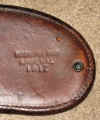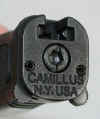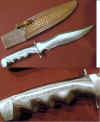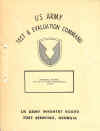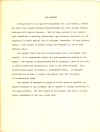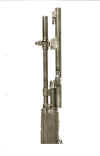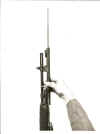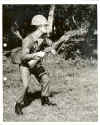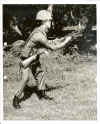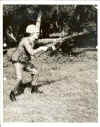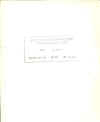Sept 2009
Carter Rila, My Friend
Our fellow collector Carter Rila (WebCat) passed away the morning of 30 Apr 09.
Carter was a cartographer by trade, pursued his craft with a passion, and took great satisfaction from these contributions to the National Defense. By avocation, he covered just about everything else. He was a historian, researcher, teacher, collector, Scouter, singer, mentor and friend.
His early years in Franklin, PA, on the banks of the Allegheny River, generated his interest in railroading and bridge engineering. Relocation to New Mexico stirred an interest in Mexico and the history of the Mexican Revolutions and the era of Pancho Villa and the US Punitive Expedition of 1914. Scouting and service as an adult Scout Leader fostered an interest in camping and outdoor skills and a passion for campfire and folk songs. His wanderings around the Southwest opened an interest in the lore and skills of the Cowboy and the lore of the Old West.
Carter was a Cold War soldier, serving as a U.S. Army Nike Missile technician on the East Coast and near Washington DC. He found access to the National Archives and immersed himself in the documentary treasures to be found there.
We knew Carter as an expert and teacher of things military - U.S. web and leather field and individual equipments; canteens and mess gear; first aid and Hospital Corps equipment and materials; aircrew survival gear, uniforms, intelligence and espionage activities, and in blacksmithing and metalwork. His interest in knives and other blades was as tools – Scout and other pocket knives, aircrew escape and survival knives, machetes and bolos, axes and entrenching tools – and he was a skilled axman. He tallied up years as a tireless researcher and reader, and gleaned countless personal histories of the common soldier of all wars for accounts and descriptions of the soldier’s experiences with the tools of the trade.
Carter was a member of the Company of Military Historians with many contributions to the Journal. His articles, and contributions to the works of other authors, have been published in magazines and books, and he currently has a collection of monographs on military blades available on the web.
During his last illness, he was still actively researching the works of reporters covering the activities of Pancho Villa and the U.S. / Mexican Border problems.
Carter was my mentor, collecting competitor and friend. He left us a rich legacy in historical research and documentation and in friendship. I, and the community, will miss him.
Carter, Rest In Peace.
Day is done, gone the sun
From the lakes, from the hills, from the sky
All is well, safely rest;
God is nigh.Above Written by GerryRA
My personal relationship with Carter started back in the old pencil and paper days long before computers and e-mail. I was forever asking questions of him and always thinking it would be the last. Carter kept on answering me, usually on the back of a post card. After some time he judged that I was serous about research and the longer letters started. He was a strict wordsmith, forever lecturing me in the proper use of a word and the subtle differences between a knife type and a knife pattern. Many of his lectures went on to become Carters Commentaries right here on this website. Carter did not suffer fools lightly nor did he like to answer the same question more then once, it was up to me to pay better attention, and he would say so.
With being precise in his research he would often go off into a left field in his answer reminiscing on his younger days and the major surplus retailers of the time. We had something in common and that was geography that he knew. In his younger days he spent time at a Nike missile base just a few miles from where I currently live. He knew the area and the town names. He would spend time in Philadelphia with the large surplus dealers and would often test me on the area. I well remember his first computer and the lengthy dissertations that would follow from that point on were epic in length and content. Carter would hit so many points I would answer or comment on them in spurts over the course of a few days or even a week.
We worked together for a few years on rewriting his book with newly found letters and evidence that would confirm his opinion or refute it and send him back to rewriting. Some chapters had many such rewrites. He had his manuscript in a handwritten form which he later transcribed on an old Apple or Commodore computer in the mid 1980’s. It did not transfer to the newer format so we exchanged chapters and two finger typed the whole book into chapters. In the end it wasn’t who was right it was the point of getting it right. Carter had many friends who had written books in which he had contributed to, his worry was in stating the fact correctly as he had seen too many of them state and opinion only to find out it was wrong and now in print.
Carter was not a condition collector, one of his favorite sayings was "on the first one condition machs nix", it doesn’t matter. I would argue the point with him but he would not change his thought on it. He believed one could always upgrade later if the item presented itself to do so. Never pass up one you don’t have regardless of the condition.
Among his pet peeves were his Military Myths and Misconceptions pages, items that seemed to take on a life of their own usually based from a partial or entirely wrong fact. The OSS machete and the Model of 1905 Hospital Corps Knives were among the favorites to lecture on. The tired old V44 story of his friend Ed Henry would not die along with the Engineer Bolo. It would be fun to sit back and watch Carter go to work on the subject with some unknowing "expert" quoting Cole or Peterson. Having been on the receiving end of those lectures from many years ago I could appreciate that he was teaching if you would only open your ears and put aside your ego.
Carter was my friend, he was funny and dear, supportive and talented, he was one of my heroes and I will miss him so.
Mk2 thickness
It varied by era and by manufacturer. The original spec called for an actual measurement of 9/64ths which was later in WW II changed to .141 +/- .010 on the 10/30/43 US Navy revision. This followed on throughout WW II.
When the drawing was revised in 1960 the spec was changed to .171 +/- .020 on USMC 1219C2 revision g.
This was changed to coincide with commercial gage 0.168 in revision N 3/4/68. The tolerance was tightened up to +/- .005 (yeah right).
This is according to drawings and blueprint revisions. In actual production records it was pretty easy, they used 8 gage steel right from the steel mills and did not change the dimensions by any surface grinding or forging. I have seen it written into a few specification sheets that 8 gage was required to pass the inspection, from that point it just wasn't checked as knives were in the domain of the Quartermaster Dept. Now bayonets on the other hand were in the domain of the Ordnance Dept. and they had gages for every dimension imaginable.
Camillus started using the .171 dimension in 1962 when they started to produce the knife again for the first time since 1945. They asked for and received permission to rewrite the specification to .164. But... continued to write their production records as .171 up to 1972 when they changed it to .166 or commercial 8 gage. .166 is still the standard although in production it is commercially procured 8 gage steel that is used as it comes from the mill.
WW II Mark 2 Box
I recently had the pleasure to see an original WW II era Mark 2 cardboard packaging box. Our good friend Col. Curt Cheeseman purchased a knife and it was packaged in this box! It was certainly a nice knife in the wrap but the box is what blew me apart! It just happened to be the last knife so the guy sold him the knife in the box, such a deal! The markings are as follows:
Cont NXSO-44148
NEG. NO. L-6236
Lot 1 Item 1
20 Ea. MK2 Fighting
Knife & Sheath
Camillus Cutlery Co.Congrats to Curt on the great box with a knife thrown into the deal!
Quote
Documents are not a factor in determining authenticity.
Documents can be a factor in establishing provenance, but only to someone who understands their severe limitations.
A person who does not understand why this is so, should never buy any item in which authenticity OR provenance is a factor in its interest or its value, because that person WILL be cheated. Not might be, will be.
BRL...
The US Property Marking
Just out of curiosity I wanted to see when the first US stamping appeared on a bayonet. While it seemed obvious it would be after July 4th 1776 I have seen multiple items stamped with the U States or US marking that were made well before the United States came into being. An excellent example of ex post facto as our good friend Carter Rila would say. Of course the item was stamped after the US was formed but when and why? Several authors refer to George Washington as putting this into effect. While George was the General did he in fact have the authority to do this and again why would he. Using 1776 as the jumping off point I started my search looking at the Congressional Record. Using the authority angle I thought that by looking for who paid the bills would most likely lead to the author of the official act. It didn’t take long to find it. A Committee report dated August 28th 1776 sent to congress that inspectors should be appointed to grade powder and the instructions in the report were to mark every keg of accepted powder with the brand USA. So the first use of the marking USA as an acceptance mark I could find is August 28th 1776 and it was used on kegs of Gun Powder. By reading other items of the times we find that theft and grading deception was alive and well in 1776 so official inspectors in the employ of the federal government were put to work. These inspectors would answer up to the Commissary General of Military Stores who had the stamps made and would issue them out. But this was all a report and a recommendation from congress so far.
The first official act for weapons marking I could find was Monday February 24th, 1777. In this we find an actual Congressional Resolution enacted.
RESOLVED: That the several states be requested to take the most effectual steps for collecting from the inhabitants, not in actual service, all Continental arms, and give notice of the number they shall collect to General Washington.
That all arms or accoutrements, belonging to the United States shall be stamped or marked with the words UNITED STATES; all arms already made to be stamped upon such parts as will receive the impression, and those hereafter to be manufactured, to be stamped with the said words on every part composing the stand; and all arms and accoutrements so stamped or marked shall be taken wherever found for the use of the States, excepting they shall be in the hands of those actually in Continental service.
That it be recommended to the legislatures of the several States, to enact proper laws for the punishment of those who shall unlawfully take, secrete, refuse or neglect to deliver, any Continental arms or accoutrements which they may have in their possession.
So we find by Congressional Resolution the acceptance and property markings were induced at different dates but by act of congress they both mean the same thing, US is an acceptance marking and a property marking. So how did the Washington legend get involved in this, further reading uncovers the mystery.
We find in a letter from General George Washington to Lt. Colonel Benjamin Flower, Commissary of Artillery in Philadelphia dated March 31st, 1777 the following…
The great waste and embezzlement of public arms and the difficulties arising from thence make it necessary that the utmost precautions should be used to restrain such infamous practices and further loss. I know no way so likely to effect it as that of putting on them some mark indicating them to be public property, and therefore request that you will have all belonging to the States, as well as those which have been lately imported, as all others as far as circumstances will permit, of stamped with the words UNITED STATES on such parts as will receive the impression, which designation should also put on all their accoutrements. This Congress determined to be done by Resolve of the 24th ulto., and if they have not, it is so essential that it could not be dispensed with, as there are and will be many public arms here which ought to be secured by the same impression, I wish you to have several stamps made and sent by the earliest opportunity to Mr. French, Commissary of Stores here with directions to advise me of their arrival that they may be immediately used.
So we find that it was not General Washington’s idea, but he enacted the resolution. We next hear from the General on April 12th, 1777 when a General Order was issued from his Morristown, NJ headquarters:
All Continental Arms, those in possession of the troops, as well as those in Store, to be marked immediately.
Commanding Officers of the Corps to see this Order put in execution, they will get the brand by applying to the Commissary of Military Stores.
This then is the start of the US marking and the actual introduction and use of the mark. We find many marks used in the early years such as…
USA, UNITED STATES, U. STATES and US.
While many of the markings depend on the size of the part we generally find the spelled out wording on large parts with the initials reserved for the smaller pieces.
Proof Marks
Sequence of Proof Marks
United States Government Armories
Springfield, Harpers Ferry, Rock Island
1799 to 1934
- According to available information, the first musket of Springfield manufacture, bearing a proof mark, appeared in 1799. The arm had the letters V.P.L. stamped on the head and the order shown. There is no record of proof marks from that date to 1802 when the letters V.F. appeared. In 1803 the letters P.V. were used, stamped on the barrel, in the order shown. In 1806, the letter V with the Eagles head, and the letter P appeared stamped on the barrel. This system of marking continued with slight variations until 1841 when the order of stamping and other slight changes were made.
- During the period 1833 to 1842, the flint lock was being supplanted by the percussion type musket, and many of the flint locks were converted, which accounts for many variations in proof marks during this period, also for their absence. However, this Eagle Head P.V. marking continued with variations as show, from 1841 to 1862.
- During the period 1862 to 1869 the change from percussion to breech loader was being made, and the same conditions as in paragraph 2 above, prevailed. In 1869, the Eagle head over Crossed Arrows, with U.S. underneath appeared. This marking continued until 1878.
- From the period 1878 to the adoption of the 1898 model Krag Jorgensen, definite information as to proof marks is unavailable. However it is assumed that on new weapons of the old type manufactured during this period, the old marking was used.
- With the advent of the 1898 model Krag Jorgensen, the proof mark was changed to the letter P stamped on the barrel, and in some cases a P was stamped on the under side of the stock just in the rear of the tang. This system of marking was extended to the Springfield Rifle, Model 1903, and has been in continuous use, with variations, to date.
- The present practice is to stamp the letter P on the barrel after the barrel has been proof fired. After the assembled rifle has been proof fired, the letter P enclosed in a circle, is stamped twice on the under side of the stock just in the rear of the tang, one behind the other. This indicates that the rifle has been fired for both proof and function. A punch mark is placed on the receiver just under the number, and also on the bolt handle, close up to the body of the bolt.
- A small letter P is stamped on the lug of the pistol barrels and on the frame of revolvers, when mark is used.
- The above data were gathered from arms of Springfield manufacture, but it is noted that arms of Harpers Ferry and Rock Island bear markings identical to those of this armory.
The above government document found in the National Archives was written in 1934. It has nothing to do with knives or bayonets but as we were discussing markings it fit here nicely.
Phrobis M9 Chevron Bayonets
It is certainly a rare bird to find one so when a whole locker full of them turned up it certainly grabbed some attention. A fellow found a whole case full of them and sold them on ebay. The first one went over the top in the price as expected, the second one for less and continued down. The seller sold a few privately for even less. In any case supply and demand dictate price and as even a few show up at the same time the price rapidly dips. Slowly as supply dries up the price will again rise. Simple economics. According to our good friend Bill Porter the first run consisted of 1200 bayonets so marked with the Buck date symbol know to collectors as the Chevron. It was noticed and the items pulled from the military but not before most were already shipped. Of the total 166 were held back by Phrobis so we have 1034 sent to general issue circulation. The 166 were split evenly between Phrobis and Buck, engraved with a number and sold / given away by those two companies. They can be found singular and mounted on a plaque. The 166 commercially sold are far easier to find then the 1034 actually issued and lost into the system.
M1905 Maxim Silencer Bayonets
Col. Townsend Whelen, while stationed at Springfield Armory, ordered the scrapping of 3,654 bayonets fitted for use with the Maxim Silencer in 1933. Just thought you may like to know where a few of them went.
Quote
"The strongest reason for people to retain the right to keep and bear arms is, as a last resort, to protect themselves against tyranny in government." – Thomas Jefferson
October 2009
Quote
Those who beat their swords into plowshares usually end up plowing for those who kept their swords.
-Benjamin Franklin
M1905 Bayonet Handles Were Browned
Today we refer to the grip portion and about one half an inch of the blade on the bayonet as being beautifully blued when originally made. Well according to the Ordnance Dept it was Browned not Blued. By 1906 the original revisions of the M1903 rifle included Browning the bolt and the bayonet from guard to pommel for invisibility reasons when sheathed. Camouflage was a word not in vogue yet I guess.
HCK Scabbards marked 1917
2,000 scabbards, Model of 1908, for Hospital Corps knife, Model of 1905 were made in fiscal year 1918 (July 1, 1917 to June 30, 1918) and examples have been seen marked 1917. Hard to say what and why for, but we do know that 2,000 scabbards were made in fiscal year 1918 according to the records. The only answer to the why question I know of would be, they were needed by someone. In effect the M1905 Hospital Corps Knife was obsoleted in 1916 right after the Villa Expedition but like many other items they were issued out to the field and kept until unusable in most cases.
As for Europe I have not seen one in any photos, I do not know if any were there. A photo is the only way I know of verification as I have not seen any records of one in the TO&E and again they were considered obsolete. There were many National Guard units at home and in the fighting, they probably had some but in most cases all equipment was discarded upon entry to Europe and new was issued.
In any case yes they were made in 1917 but for what reason I do not know.
A couple of 1917 dated Model of 1908 HCK scabbards. Yes, before you ask they are Model of 1908 scabbards, look it up. Thanks to Gunbarrel for sending photos of his recent find!
Board on Trowel Bayonets
From the Report on Operations at the Springfield Armory for the year ending 30 June 1872 we find a Board was held on Trowel Bayonets. The board was chaired by Capt. J.R. Edie, with S.W. Porter, and C. Bailey also mentioned. The would have been post the 1869 models obviously and before the Rice model produced in 1875. Always thought it unusual that the Rice Trowel Bayonet had the wooden plug handle patented by Chillingworth, another inventor and a competitor as well! Anyway does anyone have a copy or know the whereabouts of this board report?
Patents and Royalties
Did you know that at one time it was an acceptable practice for Army personnel to patent and collect royalties on items they developed while actively in the service? Thinking about Rice and Chillingworth, 10,000 bayonets made in 1875, brings to mind General Hoffman who designed the bayonet frog named after him who patented it and sold it to the US. Being a General he probably had someone else do all the work and he got the checks… Just kidding to any Generals out there reading this!
Combined Bayonet and Silencer
In 1910 Springfield Armory tested a combination silencer / bayonet for possible adoption by the military. It obviously failed the testing but it was quite a thoughtful item. It was patented by it’s inventor, Bertell W. King of NYC NY but never made it much past the testing stages. The patent is 989,158 and shown in my Bayonet Patent CD.
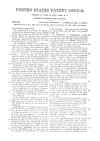

Click on thumbnails for full size illustrations
World War One Finishes
Most folks assume that the proper rough and dull WW I finish is Parkerizing, not so. Springfield was directed to omit unnecessary fine finish on all arms effective October 9, 1918. This is when the Parker Rust Proofing process was to be adopted. Well we all know that on November 11, 1918 the war ended, just over one months time. And we find a month after that Springfield was ordered to resume peace time finish standards. All in all we have a one month window of Parkerized finished being applied at Springfield Armory. But… the actual application of the Parker finish apparently continued even after the order to revert back to the peace time finish as examples can be found. Also the Marine Corps adopted the Parker finish in 1920 on the M1903 rifles so did Springfield ever revert back to bluing or was the peace time finish just the polishing and fine detail finishing work? We know that Ordnance adopted certain European finish techniques on refurbs done in the field during the war. This also produced a rough dull finish, lots to ponder on...
Another Board Request
We find in 1875 a board was convened to report on the best way of carrying intrenching tools. The board was chaired by Lt.’s Metcalfe and Rockwell. Also remember that in fiscal year 1875 we produced 10,000 intrenching tools. I am looking for a copy of this Board report as well.
It never ends… June 28, 1876 S.W. Hill of the Pa National Guard invented a new Ramrod bayonet. So a Ramrod Bayonet Experiment Board chaired by Capt. Prince and Lt. Lyle was held. Anyone have a copy??? Also we have another test dated July 12, 1876 as this was a different fiscal year it was reported again. While we have another test on Ramrod bayonets dated December 20, 1876. In this period the testing of the trowel bayonet and the intrenching tool was being carried out in full swing. We know the trowel was discontinued in manufacture and issue while the intrenching tool was issued and it started to be refined in to the Hunting knife profile. A lot was happening with bayonets and knives in the short period of time.
Bayonets for the 26 inch barreled Krag
Interesting in the testing of the Board of Ordnance & Fortifications Rifle (better known to collectors as the 26 inch Krag) no note is made of the bayonet. The barrel diameter of the 26 incher was larger so the typical bayonet would not fit. Well we find that bayonets were produced for these test rifles, the barrel ring was bored larger and a number 26 was stamped on the surface of the guard between the bore and the grip. In the testing this was determined to be the less expensive way out compared to machining and changing all the bayonet guards should the rifle be adopted. I guess the Philippine Scout rifle idea to simply turn down the muzzle of the barrel didn’t occur to anyone at the time. Try to find one of those 26 marked Krag bayonets!
Quote
"Ceremonial" is a technical term from anthropological archaeology.
It means "we don't know WTF the item is, but we need to call it something so we can get our NSF grant renewed and/or our NPS CRM contract extended."Bernard Levine
M1 Bayonets Made in Europe
We still can not find any information as to what the M1 bayonets produced at the end of WW II in Belgium look like. What was the marking on them, how many were made, when and for how long. Could it be unmarked? Frustrating endeavor…
Were U.S. Bayonets Issued Sharp??
The debate still rages on. I remember being asked this question in 1980 and I remember asking it in 1970 from a fellow who asked that same question in 1950 from a fellow who worked on the project back in 1942. So as we can see that single question has been around for quite some time. I’m just kidding but the question has been asked over the years and we hope to clear it up here and now. Below is an excerpt from Bayonets, Knives and Scabbards page 18 just for starters.
(j) Miscellaneous Problems
The question of just how sharp the bayonets should be came up repeatedly. Requests would come in from the field for a sharper edge. It was found that if too sharp a point or edges were permitted, injuries to the troops were apt to ensue during drill and practice, with the bayonets encased in leather or webbing scabbards as well as when in use on the rifles. To determine just how to have the bayonets sharp enough to please the using arms without being too sharp for safety posed a real problem. After considerable debate, orders were issued to Utica Cutlery Company to make up 15 M1905 bayonets of the desired sharpness, for distribution to the Ordnance Districts and the facilities for use as pilot models to guide inspectors.
This debate took place in May 11, 1943 and the orders were issued on May 15, 1943. As May 1943 was the last month of production on the M1905 bayonet I doubt the new sharpness order was actually used on any M1905's produced during the war. With the M1 production just getting into the swing of things and the M1905E1 conversions going full speed ahead you can bet those items fell into the new orders parameters. In March of 1945 Technical Bulletin TB ORD 272 was published with a minimum on the overall length of any bayonets that needed to be repointed. It did not address the sharpness of the bayonets but did address the way it should be done using only a water cooled stone to avoid heat damage. Again this is post M1905 production. A much earlier reference is given for the M1905 in Training Regulations No. 320-10 dated March 12, 1924 in which it states
A...the front or lower edge is sharp along it’s entire length and the back for a distance of 5 inches from the point. Sharpening stones were issued by Ordnance for hand finishing if needed but only at the armorer level. I have received several letters over the years from men who told me that the result would have been death if they were caught sharpening a bayonet. One fellow related as to how they were given erasers to remove any blemishes on the blade while it was in their care. He stated they would stick it in the sand when no one was watching to avoid the eraser work. This was usually in training or boot camp. Once in the field it was a way to pass the time and can be read in several well known works published both at the time of the war and still today. The first picture that comes to my mind of a South Pacific troop transport is a Marine sitting below deck sharpening a bayonet and then passing along the stone to the next guy. Richard Tregaskis, in his book Guadalcanal Diary described this scene:"Friday, July 31 1942:
"Some of the lads were sharpening bayonets, which indeed seemed to be a universal pastime all over the ship. I saw one with a huge bolo knife, which he was carefully preparing. Others worked at cleaning and oiling their rifles and sub-machine guns. Some of the boys had fashioned home-made blackjacks, canvas socks containing lead balls for 'infighting.'"
"Sunday August 2
"In our cabin tonight Capt. Hawkins and I talked over the coming offensive. He said the men were ready. All over the ship, he said, he had seen them sharpening their bayonets, oiling their knives, cleaning and sighting along their rifles. 'And they do
it without being told,' he said, as if awed by the phenomenon."
And again, this time a reference to usage when already ashore and in the fighting:
"I had dug an L-shaped foxhole along the chicken-wire fence line. This was what I considered a clever new foxhole design that anyone wishing to get at me had to stick his head into the short end of the L. This put his neck in a convenient position for me to grab it and rip it open with a very keen hunting knife I had bought at Jacksonville. Before I had gotten the hunting knife, I had owned a hook knife used to butcher hogs, but it was stolen from me. It was too novel for anyone to resist, it was not long in my possession. But the hunting knife that replaced this hook knife was adequate to any job, I felt, and I was proud of it. You cannot easily cut a throat with a bayonet; it was too dull. It is a stabbing weapon, anyway. So, most of us bought from our own funds various knives for emergencies, and for cooking. The bayonet was a can opener, and a good one."
A common opinion among the Marines as they did buy a bunch of knives.
Anyway it seems they were never sharp enough for the end users who would always touch them up given the chance but there was a standard right from the beginning of production for the blades to be sharp, just how sharp is sharp is debatable and probably will be for another couple of generations
Dating Late Model Ek Knives
Ek Commando Knives have a telltale etching, Richmond-marked knives can be dated as below:
Lower banner etched "Commando": 1982-1991
Lower banner etched "Gulf War": 1991-2004 (Sept.)
"Iraqi War" banner added in lower right: 2004 (Oct.) - 2008 (Aug.)
"Afghanistan" banner added to center bottom: 2008 (Sept.) -
The Old Days…
Folks always harp back on the prices in the old days. Well I also remember them well. I can't tell you how many knives I have lost, broke, gave away or had taken away (confiscated) from me as a kid. Almost all were US surplus that were a buck or two and lasted for a few weeks at best. The ones with the brass knuckle handles (M1918Mk1) were the coolest but at $8.00 they took quite a few weeks of saving to get one of them. A Navy Mark 1 was just a buck and 8 knives was always better then just one no matter how cool it was. I had a Camillus Fish knife taken away from me in school one day when I was in 9th grade. I was using it to sharpen a pencil when we were not allowed up to the sharpener because it was testing time. As you all well know a pencil with a broken point is not very good at testing time, it needed to be sharpened! So I whipped out the old course black handled Camillus Fish knife with the bail and hook remover end and proceeded to sharpen my pencil. Teacher didn’t find it amusing… must have been a Democrat. On my slow walk to the principals office I was tossing it around and hit the ceiling but it didn’t stick. I tried to explain that I didn’t do anything wrong with it, merely sharpened my pencil. It told me that times were changing and carrying a knife to school was probably not a good idea any more. Now I had carried a knife every day since 3rd grade so this was a big deal to me. Funny thing is that it was just a suggestion as there were no laws against it and as long as it was in my pocket no one would know. He took this one but I acknowledged the suggestion, we had a deal! I guess they would be been pretty upset that a few years later I had guns in my car in the parking lot, my .22 went everywhere with me. I wonder if the old guy still has the knife?
Quote
"The purpose of fairy tales is not to teach children that monsters exist. Children KNOW monsters are real. The purpose of fairy tales is to teach children that monsters may be slain".
Unknown
November 2009
Quote
Luke 22:36 - Then said he unto them, He that hath a purse, let him take it, and likewise his scrip: and he that hath no sword, let him sell his garment, and buy one.Jesus of Nazareth
RIP Marbles
"September 23, 2009; Due to extremely poor sales in the cutlery consumer market and acute downturn
in the general economy Marble’s Cutlery LLC has filed Chapter 7 Bankruptcy. Every effort was made to sell or recapitalize the company but failed. Marble Arms Inc., manufacturer of gun sights and gun related products, is a separate entity and is in no way affected by the bankruptcy.
Kennedy Knives
Fellow collector Gene Moisey sent me some photos awhile back of the tang and guard of a Kennedy knife he has with the grips off of it. There are strange markings on the tang, it appears to be punch marks. On the leather washer on the guard there are also numbers stamped in it. The numbers are a 4 and a 2 so we surmise this could very well be the year made, as in 1942. I don’t know what these mean, if they are some sort of code or what. I show them here in case someone does or even has a guess on it. Do you?

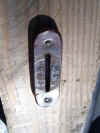
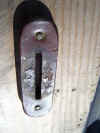
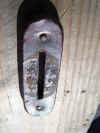
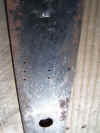

Click on the thumbnail for the full size photo
Mess Knives Again
Our good friend Dick Boyd noticed on an ebay auction a write up showing a display board, the type in factories showing models and incomplete work, that listed the board came from the Oneida plant. They were large makers of mess cutlery so that is not a surprise, what is though is the markings on the knives on the board, and M in a circle. So the M in a circle knives from WW II are connected to Oneida or so it seems. This is the first connection I know of that places the marking with that company. We have long suspected that the OM marked knives were Oneida Manufacturing but do not know that as fact. The M sure draws us closer to that conclusion for now. Not a solid fact but a very good clue to continue the search. As it turns out we discovered a listing of the Forging Industry Association trade marks. The M in a circle is a mark made by Moore Drop Forging Co. Inc. Now the search for the connection to Moore and possibly Oneida or was Moore a stand alone maker. I could not find a Moore Drop Forge Co. in the War Supply Contract book so the possibility of them being a subcontractor for Oneida is a distinct possibility. Or it may have been a very small contract under the $50,000.00 limit to put them in the book. More searching required…



Click on the thumbnail for the full size photo
Quote...
"One of the reasons for conspiracy theories is an assumption that people in high places always know what they are doing. When they do something that makes no sense, devious reasons are imagined by conspiracy theorists, when in fact it may be due to plain old ignorance and incompetence."
Thomas Sowell
Signal Corps Rebel…
Good friend Tommy Knox sent us a vintage photo of an Hispanic looking Confederate rebel soldier wearing a leather stacked handle machete, it appears to be of the standard Collins type. While we think of Civil War soldiers romantically wearing large Bowie knives with fancy handles and etched blades the common Collins machete sure does make sense as it was affordable and available to any farmer which the South had many of. Tommy looked into the date line of leather stacked handles as I have before and we can see that many were made prior to the Civil War era and the machetes may have been the first to use them in this style. Very Cool Photo!
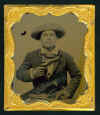
Click on the thumbnail for the full size photo
Camillus M1A1 Bayonet Prototype
While doing some research Bryan and Denise LaTourette happened across our website here. They sent me a few photos of a bayonet they have, the Camillus M1A1. The scabbard is marked with large printing 6-25-06 / Prototype. Notice the scabbard is all one color and the soft inserts are the same color as the body, something not done on the production pieces. I have not seen this marking before and show it here for historical purposes. Thanks guys for sending the photos, neat scabbard.




Click on the thumbnail for the full size photo
Microtech Mini UDT knives
We were contacted by Paul Hodgson a Microtech collector looking for any information on the Mini UDT knives sent for testing by the government. While we do hear of many items tested and submitted these days, many we do not. Newer information is also the hardest to trace as the trail we leave today does not include a lot of paper to follow up with. In the advent of Freedom of Information as well as National Security the maze just gets tougher. In any case Paul asks if we know anything about them he writes… "I know that they had made some knives for military contract trials, back in the mid 1990's, 1994 to be exact. I have been searching for these knives for more then 6+7 years. One I know that was made is a Sterile Green handle & lanyard, it is a mini UDT, blade length is 2 1/4" overall size is 5 1/2". Another which I believe was also a military trials knife, made in September of 1994 possibly has the lettering of SOF inscribed on the blade. It also is a "mini UDT" blade length is 2 1/4" overall length is also 5 1/2"." Well I can tell you I do not have any information on them but surely would love to know, does anyone??
Geneva Forge
I recently heard that Geneva Cutlery, known later as Geneva Forge closed the plant and moved to Holland when the labor union pushed them too hard on labor rules, pay and time off. Seems drastic and again is only hearsay but I have seen it happen before, can anyone document that story? Might be in some of the local papers from the 1950’s when it was actually news!
The Legendary V42 Story
We have heard several stories over the years of how someone came into a knife, gun, canteen, uniform, etc something of value just by dumb luck. I have done it myself on a few occasions and have written about a few of them. In fact some of my best discoveries have been by luck when looking for something completely different. How does the old saying go, I would rather be lucky then good… well there is some fact to that as well. Well this V42 story is documented here and now as actually taking place and just may stand for some time as THE BEST V42 STORY out there. It ranks right up with possibly the luckiest find as well. The story goes…
A friend of my brother-in-law's was getting rid of the "junk" her late husband had accumulated. He was in the U.S. Navy and stationed aboard the USS Omaha from 1940 to the end of the War. She came upon some knives he obtained during WW2 and wanted to get rid of them so no one would get hurt with them. The police told her to just "bury them in the desert". She threw them in the trash, expecting them to go the landfill. She mentioned them to by brother-in-law who told her I was interested in WW2 knives and asked her if I could have them. She agreed and he sent them to me. Included in the collection were a mint condition Marine Kabar, an unissued 1905/42 bayonet with sheath and four Case V-42 knives and sheaths. One knife had the handle replaced with a plastic one (done by one of the sailors on the ship) but the other three were still original in unissued condition. One sheath still had "USS Omaha" and the serial number "R-30" stamped on the sheath. The other two sheaths had never been stamped. It seems that her husband was in charge of the arms locker and he liked the knives and thought they would make great war souvenirs. The Omaha sailors name was John Martin and his rank was Bosun's Mate 2nd Class. His rating was "Sailmaker's Mate". Sailmaker was established 1893; disestablished 1900. Sailmaker's Mate - Established 1797; changed to Sailmaker's Mate 1c, 2c, and 3c 1921; included in Boatswain's Mate or Coxswain 1939. The B/Ms were in charge of deck parties, cargo handling and all rope and knot work. They were also in charge of the small arms locker.
One knife has "JEM" stamped on the ricasso and one other has his social security number etched in it. Two of the sheaths are plain (not stamped with "USS OMAHA" while the third one still has the USS OMAHA and serial number on it. The fourth sheath has his name, rank, USS OMAHA and nickname (SAILS) stamped on it. Attached are a couple of pictures so you can see their condition.
To think, these knives nearly ended up in a landfill and would have been lost forever. Now is that like hitting the lottery or what…. Go ahead top that story!



Click on the thumbnail for the full size photo
Good Ole Boys...
Some old photos I discovered while moving around my filing cabinet. Sometime in the mid 1990's taken at Roger Ballard's house after the Birmingham Gun Show. Note the young Yankee mixed in there, what a strange trip it's been...




Click on the thumbnail for the full size photo
Quote
"If someone has a gun and is trying to kill you, it would be reasonable to shoot back with your own gun."
The Dalai Lama, May 15, 2001
December 2009
Quote
"There is nothing more deceptive than an obvious fact".
Sherlock Holmes, The Boscombe Valley Mystery
Compilation Of Laws, Statutes and Revised Statutes
Master of the Sword – The Master of the sword shall have the relative rank and shall be entitled to the pay, allowances and emoluments of a captain mounted. Act of March 3, 1905 (33 Stat., 850)
Master of the Sword – The Master of the sword shall have the relative rank and shall be entitled to the pay, allowances and emoluments of a major during the active service of the present incumbent of that office. Act of May 29, 1917 (40 Stat., 90)
Model of 1912 & 1915 Bolo Bayonet
What is the serial number range of the two noted Bolo Bayonet?
I do not know as fact.
That being said we do know a high number of 6015 in the Model of 1915 versions and a low
number of 40 in the Model of 1912 dated version from specimens I have seen.
With 52 made the first time in Model of 1912 variations and 6002 Model of 1915 versions we have a total of 6054 made. If there wasn’t an over lap in the two numbers we would have a
possibility of 1 to 6054.
If a Model of 1915 version shows up with a number under 52 it would show an overlap which would blow that theory.
Something to think about, what serial number do you have? Send me an e-mail with your serial number please. Thank you.
Code of Bushido
Reading some about it in World War Two writings we find it was corrupted as used by the Japanese War Council. A wonderful way of life can be turned and used for evil. Here are the original concepts.
Gi - Right decision based on truth.
Gu – Bravery. Cowardice is never an option.
Jin – Benevolence. Compassion.
Rei - Right Action. Courtesy Graciousness Politeness Civility in word and in deed.
Reishiki – Etiquette. It is better to die than be impolite. Be well mannered always showing proper respect.
Makoto – Sincerity. Truth of heart.
Melgo – Humility. Glory without ego.
Chugo – Loyalty. Devotion to one who will teach you.
Battle Hymn of the Republic
Mine eyes have seen the glory of the coming of the Lord, He is trampling out the vintage where the grapes of wrath are stored; He hath loosed the fateful lightning of his terrible swift sword— His truth is marching on.
Sea Wolf Knives
I have accumulated quite a file on these over the years. Some are observations, some are articles and others are interview excerpts and even internet postings. Several of the players are also named and quoted as well. It is indeed quite and interesting story about a very interesting knife, one that I never stop receiving questions about. In that light I decided to put together a time line of the events as I know them and write it all down for easy reference. And by the way, none of them I can confirm as fact.
Gus Marsh was with the US Navy from 1967-1970. Below are the only three "Marshes" who ever graduated from BUD/S or any frogman training course whatever so all the stories of membership in UDT-13 is incorrect.
Marsh, John Carter
Marsh, Norman James
Marsh, Thomas Edward
He made 26 (some state 14) of the three-piece diving knife for his buddies. The most visible aspect of the original three-piece knives is that the three-piece knives have no name on the handle, they are what we would call sterile these days. These were made to replace the Mark 2 diving knives ruined by salt water under the leather handles eating away at the tang rods. A very small few have been seen at times but are extremely hard to come by.
From 1980-1984 Gus made about 200 of these second-generation Seawolf Diving knives and sold them at Gun Shows in California, Arizona and Nevada. When Gus decided to have knives made and become a knifemaker he had the knives cast in one piece of solid stainless steel. He received the rough-cast blanks at his home and finished them to the mirror bright configuration in his garage workshop. These knives were retailed anywhere Gus could get a sale, mainly at dive shops. These knives were made from 440C stainless steel and hardened to the Rockwell C scale of 57-58. He sold them for $150.00 each with either a leather or kydex sheath. The leather sheath generally followed the curve of the blade and had an impressed basket weave front with a snap fastening retaining strap. He did not make anymore since the last ones in 1984.
In 1986 (some state October 1988 as the correct date) he sold the rights to the Seawolf Knife to Mike England from Cordell, Oklahoma, who never paid him. Legal action was taken to stop the process but out of state lawyers are expensive. Mike has since died and Gus moved on. Mike never produced any more then a hand full of knives while he owned the equipment. His knives that he did produce are etched Mike England / Maker and Seawolf in a highly designed logo type etching. The S in Seawolf is comprised of a head of a wolf and a body of a fish. It is located about a half inch from the cross guard.
Mike England sold it to a guy named Paul (Bud) Wolf who was from Texas. When the castings came back to Paul he sent the castings out for Heat Treatment. The knives were overall sandblasted to a dull gray finish, the titanium knives were very light but rough, titanium has a very strange feel to it. Even with the sand blasting it felt dry to the touch, a unique feeling with titanium. He sold them for about $150.00 that was in about 1987 through 1989. These knives are easy to spot as the SEA is removed from the casting, they now became Wolf Knife Co. USA marked knives. Paul made some in titanium and some in stainless steel. He also made investment castings and the handle area is hollow so you can fill them with sand or lead or actually anything you want to change the balance, weight and feel of the knife. Paul seemed to fade away after that, well at least the knife did, We never heard from him again after that.
In an April 1989 Blade Magazine article on diving knives a Sea Wolf style knife is shown in one of the photographs. It is all black but the actual finish is not described as to what it is. It is listed as a very heavy integral diving knife that serves as a boating and camping tool as well. They list the manufacturer in the article as Warrior International Network. They go on to state; "If your tired of buying a new dive knife every two years because the tang has rusted out; or if your not interested in taking your knife apart every time you want to clean it, this is the knife for you" says Paul Monahan, Warrior International president. This dive knife included a kydex sheath that is not shown in the article. The knife is 440C stainless steel heat treated to 58-60 Rc. I have not seen one of these knives so can not tell you what markings it may have on it.
Later on the same knife design ended up being a ScubaPro item made in stainless steel called "The Knife" and in titanium termed "Super Knife". Scuba Pro serial numbers each knife to provide security to the original purchaser if it was registered with the company. This knife reverted back to the three piece style with the blade, guard and a plastic handle. These knives had a stag like white plastic handle. These knives were true dive knives aimed at the recreational diving crowd, the used a black plastic scabbard with leg straps and a belt loop for multiple mounting options. Now here is the crazy part, the knife was first fabricated and listed in the 1976 catalog under the stock number 543 for the stainless version and the 544 for the non mag version! Scuba Pro dropped the knife after the 1985 catalog but items were known to have been sold up to 1989 at least and these later items lacked the serial numbering. Going just by observed serial numbers it may have been up to 20,000 knives were produced by ScubaPro in Italy. As an outside guess, a deduction, a stretch, I would say the design was never patented or trademarked so it was just used by others.
That is the story as I know it as of 6/1/09 with all sources combined into one place. I have stated in parenthesis the items which are at odds with others and both coming from good sources. It may just be a case of miss remembering as none of these figures were written down in contract or historical form when it was happening. Now you know as much as I do about Sea Wolf knives.
Liberty Electric Co.
Liberty Electric Co, was a subcontractor in World War Two that assembled E-1 Emergency Sustenance Kits for the US AAF. Packed in this kit was a Camillus made hunting knife, pattern 5665 L66. The order was split with stagged bone and stagged rosewood grips. The grips were attached by two 12 gauge steel pins. The blade was stamped with the Camillus name and was packed with a special sheath made be J H Mosser having 11 small round headed rivets. The 5 inch blade and steel guard were highly polished and treated with grease before packing to stop the rust. Camillus states they supplied 35,500 to Liberty Electric who packaged the components into the E-1 kit. Camillus being the sub-contractor on this component the government procurement records hold no information on it. Thankfully we have the Camillus archive records. One of the relatively obscure knives of the US military.
Conceptual Bayonet Infantry Board 1965
Here is one you can read about for the first time, The Infantry Board Test of a Conceptual Retractable Bayonet. In 1965 the standard Main Battle Rifle was the M14. The new rifle then being tested did not have a bayonet so the Infantry Board initiated a test for requirements. The new design was constructed to take up as little space as possible, be light in weight and be always available when the rifle was. The following photos show the bayonet up close and a Staff Sgt, posing for official photos. Remember you saw it here first.
AAF One Page Recommendation
We recently received an e-mail from good friend Dustin Clingenpeel that contained a one page recommendation from an Army Air Forces document. It is page 93 of the larger document and lists the Knife, Pocket, Mountain (QMC) 74-K-80 and the Knife, Pocket, Marine, All Metal (USMC). It compared the two and gave the following discussion:
Both of these knives were used throughout the test period. The Knife, Mountain was a little too short for heavy cutting. The Knife, Marine (sic) was difficult to open as the thumb groove was between the blades instead of on the outside. The can opener on the latter knife was especially efficient. Both were highly satisfactory all purpose knives.
Suggested Improvements – None
Recommendation: That one or both of these items be made available to the AAF Search & Rescue organizations in Cold Climate Regions.
One did end up in the post war kits, guess which one? The trusty MIL-K-818 became the all services knife for the next 60 years and still counting.
Famous Last Words...
"Here, hold my beer and watch this!"
AnonymousIf you wish to be placed on the mailing list to be notified when the Website is updated, drop us a line. E-mail us here trz123@comcast.net
Check out our books for sale, some good ones, new and used have just arrived! We have the Coniglio M3 Trench Knife book back in stock also






